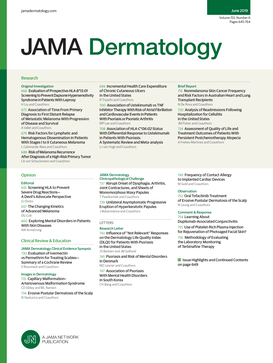JAMA Dermatology
JAMA Dermatology[edit | edit source]
JAMA Dermatology is a peer-reviewed medical journal that focuses on the field of dermatology. It is one of the JAMA Network journals published by the American Medical Association. The journal provides a platform for the dissemination of significant research findings, reviews, and clinical studies related to skin health and diseases.
History[edit | edit source]
JAMA Dermatology was originally established in 1960 under the name Archives of Dermatology. In 2013, the journal was renamed to its current title as part of a rebranding effort by the JAMA Network to unify its family of journals under a common identity.
Scope and Content[edit | edit source]
The journal covers a wide range of topics within dermatology, including but not limited to:
- Clinical dermatology
- Dermatopathology
- Pediatric dermatology
- Cosmetic dermatology
- Dermatologic surgery
- Cutaneous oncology
JAMA Dermatology publishes original research articles, reviews, case reports, and clinical trials. It also features editorials, commentaries, and letters to the editor that provide insights and discussions on current issues in dermatology.
Editorial Process[edit | edit source]
The journal employs a rigorous peer-review process to ensure the quality and integrity of the articles it publishes. Manuscripts submitted to JAMA Dermatology are evaluated by experts in the field, and decisions are made based on the novelty, significance, and scientific rigor of the research.
Impact and Influence[edit | edit source]
JAMA Dermatology is widely regarded as a leading journal in the field of dermatology. It has a high impact factor, reflecting its influence and the importance of the research it publishes. The journal is read by dermatologists, researchers, and healthcare professionals worldwide, contributing to advancements in the understanding and treatment of skin diseases.
Related Pages[edit | edit source]
Search WikiMD
Ad.Tired of being Overweight? Try W8MD's physician weight loss program.
Semaglutide (Ozempic / Wegovy and Tirzepatide (Mounjaro / Zepbound) available.
Advertise on WikiMD
|
WikiMD's Wellness Encyclopedia |
| Let Food Be Thy Medicine Medicine Thy Food - Hippocrates |
Translate this page: - East Asian
中文,
日本,
한국어,
South Asian
हिन्दी,
தமிழ்,
తెలుగు,
Urdu,
ಕನ್ನಡ,
Southeast Asian
Indonesian,
Vietnamese,
Thai,
မြန်မာဘာသာ,
বাংলা
European
español,
Deutsch,
français,
Greek,
português do Brasil,
polski,
română,
русский,
Nederlands,
norsk,
svenska,
suomi,
Italian
Middle Eastern & African
عربى,
Turkish,
Persian,
Hebrew,
Afrikaans,
isiZulu,
Kiswahili,
Other
Bulgarian,
Hungarian,
Czech,
Swedish,
മലയാളം,
मराठी,
ਪੰਜਾਬੀ,
ગુજરાતી,
Portuguese,
Ukrainian
Medical Disclaimer: WikiMD is not a substitute for professional medical advice. The information on WikiMD is provided as an information resource only, may be incorrect, outdated or misleading, and is not to be used or relied on for any diagnostic or treatment purposes. Please consult your health care provider before making any healthcare decisions or for guidance about a specific medical condition. WikiMD expressly disclaims responsibility, and shall have no liability, for any damages, loss, injury, or liability whatsoever suffered as a result of your reliance on the information contained in this site. By visiting this site you agree to the foregoing terms and conditions, which may from time to time be changed or supplemented by WikiMD. If you do not agree to the foregoing terms and conditions, you should not enter or use this site. See full disclaimer.
Credits:Most images are courtesy of Wikimedia commons, and templates, categories Wikipedia, licensed under CC BY SA or similar.
Contributors: Prab R. Tumpati, MD

